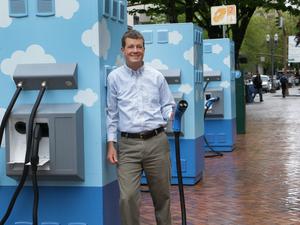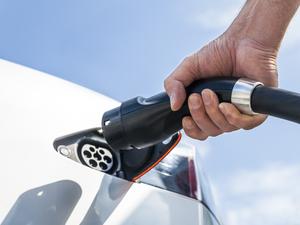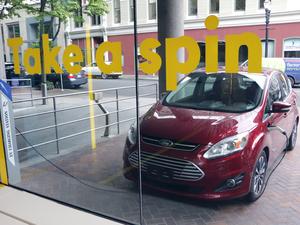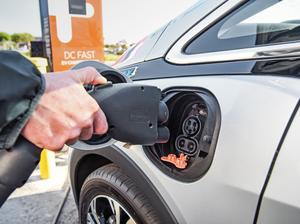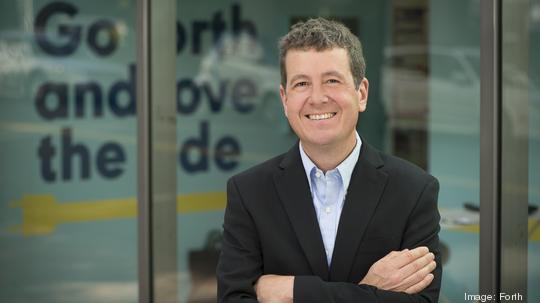
The annual Forth Roadmap Conference is back in person this week for the first time since 2019, bringing a deep roster of electric vehicle and charging industry players, transportation policy leaders and other experts to the Oregon Convention Center.
The event comes amid surging EV interest — U.S. sales of plug-in electrics nearly doubled from 308,00 in 2020 to 608,00 in 2021 — that suggests the long-percolating transition from internal combustion engines might soon become a gusher.
To get a read on the situation ahead of the conference we spoke with Forth Executive Director Jeff Allen. Allen has led the organization since 2011, guiding it from a Business Oregon-funded industry initiative called Drive Oregon to a self-sufficient nonprofit that is engaged at regional, national and international levels. The conversation was edited for brevity and clarity.
Is the momentum so strong now that it’s inevitable that EVs will replace gasoline-powered vehicles? I’m reluctant to say anything is inevitable. I remember folks coming off the global climate meetings in Kyoto (in 1997) saying, ‘We've solved climate change, we have this great Kyoto Protocol, it's inevitable.’ And here we are still trying to claw our way back. But I would say it feels like we are in the midst of a massive transformation of the transportation system. And if it’s not inevitable yet it is becoming more inevitable every day.
How much credit does Elon Musk deserve for getting the world to this point? I don’t want to over glorify him as an individual. He’s clearly had a lot of really smart people working at Tesla. So let me put it this way: I think Tesla deserves a ton of credit for getting us where we are because they produced a really cool product that people really wanted. They demonstrated that the demand was there. And when it comes to charging networks, they have set the standard for what a really good national charging network looks like. So they set the standard on the vehicles that legacy OEMs have been chasing, they set the standard on charging that the charging companies have been chasing. Arguably, they’re doing a similar thing in heavy-duty vehicles, even though, as is typically the case, their promises have been a little bit ahead of their delivery. There was a significant change in attitude from companies like Daimler about the feasibility of electric long haul trucks once Tesla got into that game — that really inspired it.
What things give you hope that EV adoption will continue to grow? To start, the technology has gotten dramatically better and cheaper over the last 10 years. You now have 250-mile-range cars that are better performing at very close to the same initial purchase price and are tons cheaper to operate and much more fun to drive (than gasoline-powered cars). The industry sees the writing on the wall and has started investing substantially in production, facilities, battery factories, etc. And policy is aligned. It has been in Europe and Asia for some time, but it is now in the U.S. as well. California is about to update its car standards to end the sale of new gas cars after about 2035. And Oregon, Washington and a bunch of other states will then follow suit. So all of those tailwinds are blowing in the right direction. Not to mention, you know, $6-a-gallon gasoline.
What risks do you see? This huge industrial transformation is happening in the midst of a massive supply chain disruption, so the big problem now is you can’t find an electric car to buy. We can’t produce them fast enough to meet the demand. I also think there are a bunch of things we need to do to go from 5% of new cars sold being electric to 100%. What works for the first 5% of customers isn’t going to work for the other 95%, charging being a key example of that. The first people to buy EVs tended to be people who had a garage. They can charge at home. But the last statistic I saw was at least 20% of Americans don’t have a garage. So what are we going to do there? I think there’s also a risk of letting off the accelerator too soon on the policy and investment side. There’s some great investments in electric transportation in the bipartisan infrastructure law, but I’ve been stunned how quickly the conversation pivoted from, ‘EVs are never going to happen’ to ‘It’s inevitable, and therefore we don’t need to do anything.’ That comes from the oil industry, saying, ‘Oh, you don’t need to support this anymore.’ And it also comes from the left, people saying, ‘Well, we don’t really like cars in the first place. We told these companies to have to make them, so we’re done, that’s all we’ve got to do.’
Some people see electrification as a distraction from planning communities so that cars aren’t needed and mostly go away, right? One of the things I’m really excited about at Roadmap is we’re going to put that conversation on the main stage for a plenary discussion, framing it, by the way, as how do we get past this false conflict. Because it is a false conflict. Compare it to the grid and electricity generation. We’ve been working for 50 years to clean up the way we produce electricity and we’ve known all through that time that the best thing is to be more energy efficient. So we’ve been working really hard to make appliances more energy efficient, etc., even as we clean up the grid. I very rarely hear anyone in that space say that building solar panels is a distraction from the real challenge, that putting up wind farms is a terrible idea because it’s distracting us from reducing our electricity use. And by the way, we’re still supporting solar and wind, even at a time when it’s already more cost-effective than coal or natural gas in most place. It blows me away that people look at the transportation challenge, which is a lot harder, and think we don’t need policy support anymore. There’s so much to do. We need better transit, we need better bike and pedestrian facilities, we need to change the way we pay for transportation so that we’re sending people price signals about the cost they’re imposing. And we need to electrify everything.
How meaningful was the EV charging money included in the infrastructure bill? At Roadmap we’re having a whole daylong side workshop on Tuesday just talking about the federal EV charging money, which is about $7.5 billion. It’s a lot of money, but when you start to break it down it gets smaller and smaller. For Oregon, it’s about $50 million over a five-year period, so about $10 million a year. It is absolutely not enough to build all of the charging that needs to be built. Nationally, one of the best numbers I’ve seen was that we need to spend something like $39 billion for public charging over the next 10 years.
Should government be building fueling stations for EVs? Government didn’t build gas stations. The gas station analogy trips a lot of people up. We didn’t pay to build gas stations, but we did pay to build a grid that delivers electricity to farms in the middle of nowhere. We did pay to build the interstate highway system. And the rationale in both cases is that we want everyone to have access. Ultimately, it’s going to be the people using the system who are going to pay for most of the costs and most of the ongoing cost.
A recent Wall Street Journal article that got a lot of attention depicted the challenges of doing an EV road trip. I’m sure you saw the piece. What were your thoughts? My first thought was that The Wall Street Journal has done that article every six to 12 months for the past five or 10 years. It’s a real fixation of theirs. And this is one of my criticisms, frankly, of the infrastructure law, this fixation on driving across the country in an EV when we know nobody does that! Maybe every few years, if ever? My other reaction is, yeah, that’s why we need to make this charging investment, so on those rare occasions where you do make long road trips, you can do that in your electric car. But we need to be real about how rarely it comes up. And, you know, also be real about even if we stopped selling gas cars tomorrow, there’s going to be a lot of them around for the next 10 or 20 years. So if you want to go cross-country, you can rent one.
If you’re a business leader in Portland, what should you be thinking about when it comes to the transition to electric transportation? The first thing to do is to recognize there is a huge transformation happening — the electrification of transportation and the smartening of transportation. It’s getting electric and it’s getting much smarter, shared, connected, eventually autonomous. So any business should be thinking about how is that going to impact us? Any business with employees should be thinking about how they take advantage of this transformation to help make it cheaper and easier for employees to get to the office if we expect them to come into an office once in a while. How do we take advantage of this to attract and keep good employees? So simple things like providing charging at work, providing information or incentives about electric vehicles. There’s that whole employee side of things, especially with $6-a-gallon gas. Then if you’re a business that has customers coming to you, it’s similar — those customers are increasingly going to be looking for places to charge. Even if they don’t necessarily need it, it’s going to signal that you are a tech-friendly, climate-friendly, forward-thinking business. Then moving your products around, obviously, you want to be thinking about how can we save money by electrifying that goods movement. It’s shocking how many businesses have either fleets of vehicles or they have employees who are driving around for the business. And again, if you’re paying employees 50 cents a mile, or whatever the IRS rate is (editor’s note: early this month the IRS raised the standard mileage rate for business travel 4 cents per mile to 62.5 cent for the remainder of the year), or if you’re paying for gas and diesel in those vehicles, you’re just burning money.
